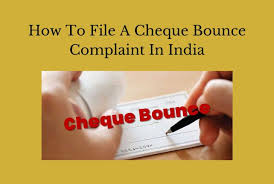AdVocate harshit Sachar | chamber no: 617 | district courts ludhiana | 2817 gurdev nagar ludhiana | ✆+91 7889228369
How to File a Case under Section 138
A step-by-step guide on how to file a cheque bounce case under Section 138 of the NI Act.
Team Sachar Law Firm
8/4/20252 min read


How to File a Case under Section 138 of the Negotiable Instruments Act
Section 138 of the Negotiable Instruments Act, 1881, deals with dishonour of cheques due to insufficient funds or if the cheque exceeds the arrangement with the bank. A cheque bounce is a criminal offence, and the law provides an effective remedy to recover the amount legally due.
Here’s a step-by-step explanation on how to file a cheque bounce case under Section 138:
**1. Prerequisites Before Filing the Case
You can file a complaint under Section 138 if:
The cheque was issued towards the discharge of a legally enforceable debt or liability.
The cheque was presented within 3 months from the date of issue.
The cheque was returned by the bank due to insufficient funds or payment stopped.
A legal demand notice is issued to the drawer within 30 days from the date of cheque return.
The drawer fails to make payment within 15 days from receiving the notice.
**2. Send a Legal Demand Notice
Draft a formal legal notice demanding payment of the cheque amount.
Mention cheque details, date of bounce, bank memo, and the liability.
Send the notice through Registered Post/Speed Post with acknowledgment or by courier.
Keep copies of the notice, postal receipt, and delivery status as proof.
**3. Wait for 15 Days
After the drawer receives the notice, wait for 15 days for the payment. If they fail to pay within this time, you are entitled to file a criminal complaint.
**4. File the Criminal Complaint
The complaint must be filed within 30 days after the expiry of the 15-day notice period.
The complaint is filed before the Magistrate Court (usually Judicial Magistrate First Class) having jurisdiction based on:
Where the cheque was presented (bank branch),
Where the cheque was returned unpaid,
Where the notice was issued, or
Where the payment was to be made.
**5. Documents Required
Original cheque and cheque return memo (bank slip showing reason for dishonour)
Copy of the legal notice and postal/courier receipts
Acknowledgment or tracking report of delivery
Your affidavit and a written complaint
**6. Court Procedure After Filing
The court takes cognizance and may issue summons to the accused.
The accused appears, and trial proceeds like a criminal case.
The burden to prove that cheque was issued towards a legal liability lies on the complainant initially.
If convicted, the drawer may face imprisonment up to 2 years, fine up to double the cheque amount, or both.
**7. Additional Remedies
A civil recovery suit can also be filed simultaneously to claim the amount due.
If the drawer fails to appear, the court may issue a bailable or non-bailable warrant.
Conclusion
Section 138 of the NI Act is a powerful tool to recover money in cheque dishonour cases. However, strict timelines and procedural compliance are essential. Engaging a professional lawyer ensures that your complaint is drafted properly and filed within the legal framework to get the best possible outcome.
Services
Expert legal advice across various practice areas - Civil, Criminal, Divorce and Matrimonial, Consumer and Corporate laws, Bail Matters, Property Contract Disputes, Insurance claim disputes, cyber Crime cases, Cheque bounce, Family Divisions, Arbitration. Bail Matters, Electricity Board Cases, Appeals before Session court Ludhiana, Marriage certificate, Court Marriage.
“Get in Touch with Sachar Law Firm”
Quick Links
© 2025. All rights reserved.
Advocate Harshit SACHAR
2817, 1st Floor , Gurdev Nagar, Ludhiana, Punjab -141001
Address: Office Cum Res:
Corporate Liquidation and Recovery Litigation
☎️ 0161 7965410
